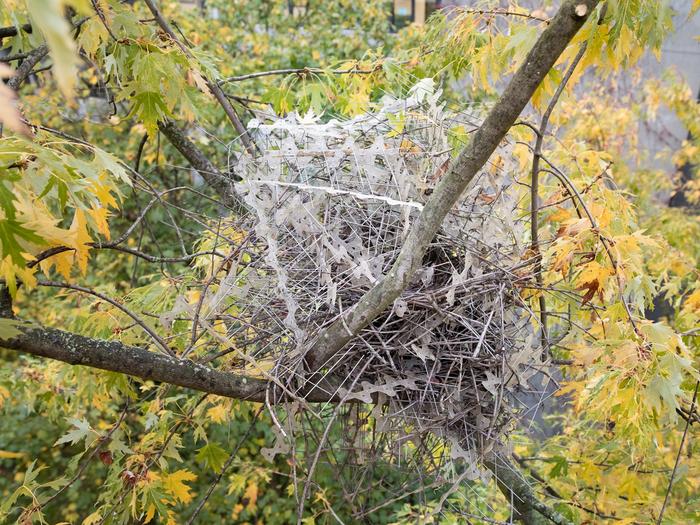Biologists present the latest innovation in nest building: bird nests made from anti-nesting spikes. Researchers from Naturalis Biodiversity Center and the Natural History Museum Rotterdam collected these special nests for the first time and described this remarkable behavior in a scientific publication as ‘an ultimate adaptation to life in the city.’

Credit: Auke-Florian Hiemstra
Biologists present the latest innovation in nest building: bird nests made from anti-nesting spikes. Researchers from Naturalis Biodiversity Center and the Natural History Museum Rotterdam collected these special nests for the first time and described this remarkable behavior in a scientific publication as ‘an ultimate adaptation to life in the city.’
If you look around in cities, you can see anti-bird spikes on many buildings. The sharp metal spikes are placed to scare away birds, and to prevent them from building nests. But birds are not so easily scared away, it now appears. Researchers from two Dutch natural history museums collected nests of a carrion crow and a Eurasian magpie that were largely built with material that should have deterred birds: bird nests made of anti-bird spikes. “It’s like a joke, really” says biologist Auke-Florian Hiemstra of Naturalis: “Even for me as a nest researcher, these are the craziest bird nests I’ve ever seen.”
The adaptability and creativity of urban birds seem to know no bounds. Researchers from Naturalis Biodiversity Center and the Natural History Museum Rotterdam describe these spiky structures in the scientific journal Deinsea. “Just when you think you’ve seen it all after half a century of studying natural history, these inventive crows and magpies really surprise me again,” said Kees Moeliker, director of the Natural History Museum Rotterdam and co-author of the scientific publication.
1500 metal spikes
It started with the discovery of a huge nest in Antwerp, in the courtyard of a hospital, which was spotted by one of the patients. High up in a tree, magpies made a huge nest of up to 1,500 metal spikes. For this particular nest, birds have pulled as many as 50 meters (150 feet) of anti-bird pins from the eaves. “An impregnable fortress”, says Hiemstra, “because the magpies appear to be using the pins exactly the same way we do: to keep other birds away from their nest.”
Magpies make a roof on their nest to prevent the robbery of eggs and young, and they specifically look for thorny plants in nature for this purpose. Spiky branches keep hungry egg robbers away. In the city there is another option: the anti-bird spikes. “They are literally made to keep birds at bay,” says Hiemstra, “which is how they seem to be used by birds as well.”
Rebel birds
And it is not just one pair of magpies that have ventured into the bird-repellent material. The article describes several magpie nests with anti-bird spikes as nesting material. This behavior has already been seen in the Netherlands, Belgium and Scotland. Other sharp materials, such as barbed wire and knitting needles, are also used by magpies for the roof of their nests. Crow’s nests made of anti-bird spikes are currently only known from the Netherlands.
It was already known that birds are not easily deterred by the pins. The ‘Parkdale Pigeon’ gained fame for not being scared away by anti-bird pegs and several videos show the rebellious behavior of birds tearing the spikes off roofs. The collaboration between the Leiden and Rotterdam museums has now resulted in the first scientific publication showing that birds also use those anti-bird pins as nesting material.
Condoms and cocaine
Auke-Florian Hiemstra (1992) is doing a PhD at Naturalis and Leiden University on the use of artificial materials in animal structures, and has previously published on the use of face masks and plastic plants in bird nests. He also regularly encounters condoms, fireworks, cocaine wraps, sunglasses and windshield wipers as nesting material for his coots. “If even bird-repellent sharp spikes are used as nesting material, apparently anything can end up in a bird’s nest these days. It doesn’t get any crazier than this, does it?”
The large magpie’s nest of anti-bird pins from Antwerp can be seen from 11 July as a new highlight in the LiveScience room of Naturalis, which can be visited free of charge. The Natural History Museum Rotterdam exhibits the crow’s nest of anti-bird pins in the recently opened exhibition ‘National Park Rotterdam’, along with a number of other remarkable constructions of urban animals.
More information, not for publication
- For questions about the publication, contact Auke-Florian Hiemstra.
- The article by Hiemstra et al is published in Deinsea.
- For general questions you can contact the Naturalis press office through 071 – 7519 648 or [email protected]
- High-resolution versions of the images above can be found in this press folder. Credit for the press pics: Alexander Schippers. Credit Drone images: Mike Muizebelt. Credit nest pictures: in the file names.
Method of Research
Observational study
Subject of Research
Animals
Article Title
Bird nests made from anti-bird spikes
Article Publication Date
11-Jul-2023




